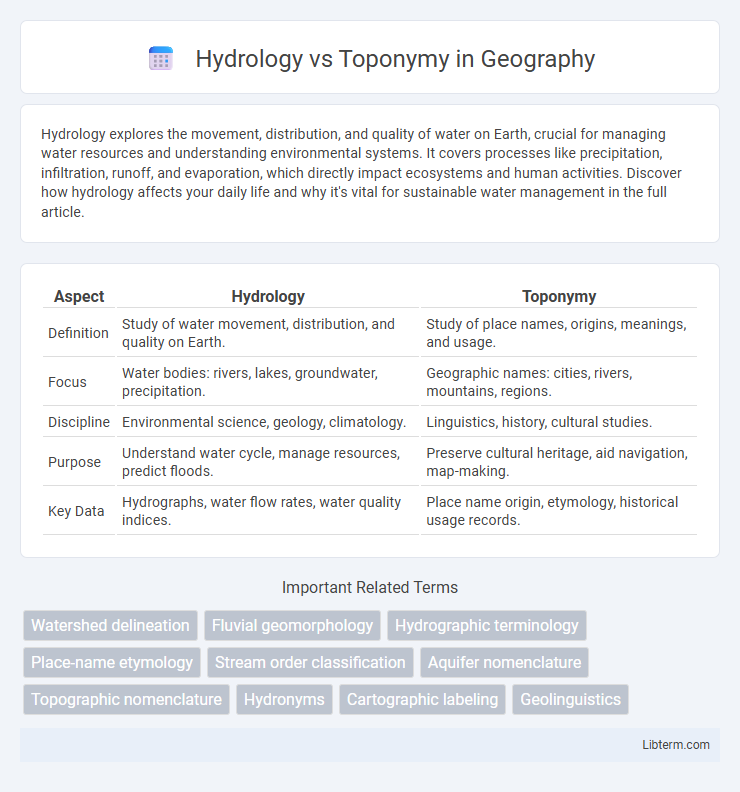Hydrology explores the movement, distribution, and quality of water on Earth, crucial for managing water resources and understanding environmental systems. It covers processes like precipitation, infiltration, runoff, and evaporation, which directly impact ecosystems and human activities. Discover how hydrology affects your daily life and why it's vital for sustainable water management in the full article.
Table of Comparison
| Aspect | Hydrology | Toponymy |
|---|---|---|
| Definition | Study of water movement, distribution, and quality on Earth. | Study of place names, origins, meanings, and usage. |
| Focus | Water bodies: rivers, lakes, groundwater, precipitation. | Geographic names: cities, rivers, mountains, regions. |
| Discipline | Environmental science, geology, climatology. | Linguistics, history, cultural studies. |
| Purpose | Understand water cycle, manage resources, predict floods. | Preserve cultural heritage, aid navigation, map-making. |
| Key Data | Hydrographs, water flow rates, water quality indices. | Place name origin, etymology, historical usage records. |
Introduction to Hydrology and Toponymy
Hydrology studies the movement, distribution, and quality of water on Earth, encompassing processes like precipitation, evaporation, and groundwater flow. Toponymy examines the origin, meaning, and usage of place names, providing insights into cultural, historical, and geographical contexts. Both fields intersect in analyzing how natural water features influence place naming and how toponyms reflect hydrological characteristics.
Defining Hydrology: Scope and Importance
Hydrology studies the distribution, movement, and quality of water on Earth, encompassing surface water, groundwater, and precipitation patterns essential for managing water resources and predicting natural hazards. Its scope includes analyzing hydrological cycles, watershed management, and flood forecasting, making it critical for environmental sustainability and urban planning. By understanding hydrological processes, policymakers can address challenges like droughts, water pollution, and climate change impacts effectively.
What is Toponymy? Origins and Relevance
Toponymy is the study of place names, their origins, meanings, and use, providing valuable insights into cultural history and geographic identity. It explores linguistic roots, historical events, and environmental features that influence naming patterns across regions. Understanding toponymy enhances navigation, cartography, and heritage conservation within the broader field of geography.
Key Differences Between Hydrology and Toponymy
Hydrology studies the movement, distribution, and quality of water on Earth, focusing on rivers, lakes, groundwater, and the water cycle, while toponymy examines the origin, meaning, and usage of place names. Hydrology relies on scientific methods such as hydrological modeling and water sampling, whereas toponymy involves linguistic analysis and historical research to understand geographic naming conventions. Key differences include hydrology's emphasis on physical water processes versus toponymy's focus on cultural and linguistic aspects of geographic nomenclature.
Intersection: How Hydrology Influences Place Names
Hydrology significantly shapes toponymy through the naming of places based on water features such as rivers, lakes, and wetlands, reflecting the geographical importance of water bodies in human settlements. Place names like Mississippi, derived from Native American terms meaning "great river," illustrate the direct influence of water systems on linguistic heritage. This intersection of hydrology and toponymy provides critical insights into historical water resource management and cultural geography.
Methods and Tools in Hydrological Studies
Hydrological studies utilize advanced methods such as remote sensing, Geographic Information Systems (GIS), and hydrological modeling to analyze water cycles, distribution, and quality. Tools like rain gauges, satellite imagery, and flow meters provide precise data for monitoring surface and groundwater resources, enabling accurate prediction of floods and drought patterns. In contrast, toponymy primarily employs linguistic analysis and historical cartography, focusing on place names rather than environmental data collection.
Techniques and Approaches in Toponymic Research
Toponymic research employs linguistic analysis, historical cartography, and geographic information systems (GIS) to study place names, revealing cultural, historical, and environmental insights. Techniques such as phonological study and etymological tracing help decode the origins and meanings of toponyms, while GIS enables spatial analysis and visualization of name distributions across landscapes. Integrating archival documents and oral histories enhances the understanding of toponymic evolution, complementing hydrological data for a comprehensive environmental context.
Real-World Applications: Hydrology and Toponymy Collaboration
Hydrology and toponymy collaboration plays a crucial role in environmental management by integrating water cycle analysis with geographic naming conventions for accurate mapping and resource planning. Real-world applications include flood risk assessment, watershed management, and urban planning, where hydrological data combined with toponymic information enhances spatial data systems used by policymakers and engineers. This synergy improves disaster response strategies and supports sustainable development through precise identification and monitoring of water bodies and related land features.
Case Studies Illustrating Hydrology-Toponymy Links
Case studies of hydrology-toponymy links reveal how water bodies shape place names, such as the Mississippi River influencing numerous settlement names in the United States. In the Amazon Basin, local toponyms often reflect seasonal flooding patterns and river characteristics, demonstrating indigenous knowledge encoded in geographical nomenclature. European examples like the Thames in England show historic hydrological features impacting urban development and naming conventions over centuries.
Future Trends in Hydrology and Toponymy Research
Future trends in hydrology research emphasize integrating advanced remote sensing technologies and AI-driven models to improve water resource management and predict climate change impacts with greater accuracy. Toponymy research is increasingly leveraging geospatial data analytics and digital mapping platforms to preserve cultural heritage and resolve naming disputes in multicultural regions. Collaboration between hydrologists and toponymists is expected to grow, facilitating comprehensive environmental studies that combine water systems analysis with place-name evolution and regional identity.
Hydrology Infographic

 libterm.com
libterm.com